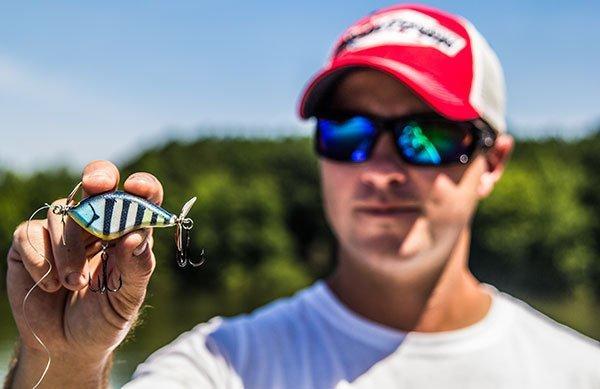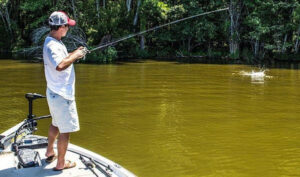The fishing industry is flooded with countless topwater lures. With minimal effort, you’ll find some that swim, walk, chug, spit, buzz, flutter, gargle, dart, dash and bubble. In all of the excitement over new baits and presentations, be careful not to overlook one of the most effective topwater lures for summer bass fishing—the prop bait.
Two-time BFL All American and custom lure designer Kip Carter is well renowned for his prop bait prowess. While many anglers flock to deeper water in the heat of the summer, Carter’s prop bait bite is at its best.
Why do they work so well?
Summertime bass are notorious for being stubborn and prop baits have some unique characteristics that can coerce some amazing strikes from even the most lethargic bass.
“Prop baits are outstanding during the summer for 2 primary reasons,” Carter said. “Summer bass require a little more ‘teasing’ at times and a prop bait sits over their heads longer than many presentations. The bright flash of the blades also irritates them and draws reaction strikes from otherwise inactive bass. Not to mention, it seems like nobody throws them anymore.”
I was in the boat with Carter and it really opened my eyes to the effectiveness of prop baits. More times than not, he would let me pitch a soft plastic or toss a shallow crankbait into areas before he would ever make a cast. After a few of my fruitless attempts, Carter would sling his prop bait into the same area and whack a 4-pounder. Needless to say, I’ve quickly become a believer.
What to look for in a prop bait
Bass anglers love to tinker with lures, and Carter is no exception. After years of customizing several mass-produced prop baits, he decided to expand his Bass Hound Crankbaits line and make his own from scratch. In order to increase his number of bites and hookup ratio, there are 3 characteristics he heavily stresses when it comes to choosing a quality prop bait.
“First and foremost, I designed my prop baits to sit straight in the water while at rest,” Carter said. “Not only does it look very unnatural for a prop bait to fall on its side, but it will also cause you to miss a lot of fish because it puts a lot of wood between the bass and the hooks.”
Carter is also a big proponent of a prop bait that doesn’t move very far when twitched. This technique is most effective when target casting, so he aims to keep his lure in the most productive strike zones for as long as possible.
“I prefer my prop baits to move 3 to 6 inches when I twitch them,” Carter said. “You don’t want them to glide across the water because it doesn’t give inactive bass enough time to react. I want to hit it about 4 or 5 times and have it stay in a 1 1/2-foot area. A prop bait is designed to irritate a bass as much as possible.”
The final ingredient to an effective prop bait is balsa wood, according to Carter. Using prop baits is a very visual presentation, making buoyancy an important factor to consider.
“When I hit a prop bait, I don’t want one that dives down,” Carter said. “If necessary, you need to be able to work it in quick, short spurts and a diving prop bait takes that option away from you. I’ve also found diving prop baits to spook wary bass, too. It can almost give them too good of a look at it, which can make them think twice before biting.”
When and where to use it
When most of us consider topwater techniques, we immediately think of lowlight conditions. Carter, however, catches his biggest summer bass when the sun is at its brightest. Shade plays a big role in his prop bait strategy.
“It’s all about the shade when you’re talking about prop baits,” Carter said. “When the sun gets high, summertime bass will either go deep or flock to shade. Shady areas allow you to pinpoint prime areas because it concentrates them. You can almost call your shots, because 9 times out of 10, they’ll be sitting on the edge of a dark spot.”
Although he’s had some success using prop baits in stained water, Carter does most of his damage in clear water areas. His strategy for finding big bass is largely dictated by recent precipitation.
“If you’ve had some recent rain, start in the back of shallow pockets near feeder creeks,” Carter said. “The runoff increases the oxygen levels in the water and you’ll be surprised how shallow they’ll get. If it’s a dry summer in your area, look for shallow water close to deep water. Bass will sit on break lines and use them as ambush points when they hear your prop bait making commotion.”
Presentation and gear for prop baits
Carter likens his prop bait presentation to that of a topwater popper. He uses very short, downward rod twitches to achieve the optimum presentation.
“I like to twitch the prop bait about 3 times and simply kill it for a few seconds,” Carter said. “When the fish are more aggressive, I’ll only kill it for about a second, but when the fish are being lazy and stubborn, I twitch it much harder to make it as loud as possible to force the fish to react.”
Many bass fishing presentations allow for some wiggle room in regards to line selection, but that isn’t the case with prop baits. To reduce frustration and allow for the most natural presentation, Carter uses 17 to 20-pound monofilament line.
“Monofilament is essential for prop baits because it floats and stays out of the blades,” Carter said. “Fluorocarbon kills the action and causes the lure to nosedive, while braid gets tangled in the blades and hooks.”
Carter prefers a 7-foot, medium-heavy Big Bear Microguide Casting Rod for improved casting accuracy. The responsive tip won’t rip the hooks from the bass’ mouth while the stout backbone proves heavy enough to rip the bass from precarious areas.
Take it from someone who recently got embarrassed by a prop bait—go outside of your comfort zone this summer and experiment with a prop bait. You may not catch 30 fish per day on it, but you’ll be pleasantly surprised by the number of quality bites it creates.
To purchase Carter’s custom Bass Hound prop baits and browse his selection of outstanding, hand-carved balsa crankbaits, visit HomeBrewedTackle.com.














